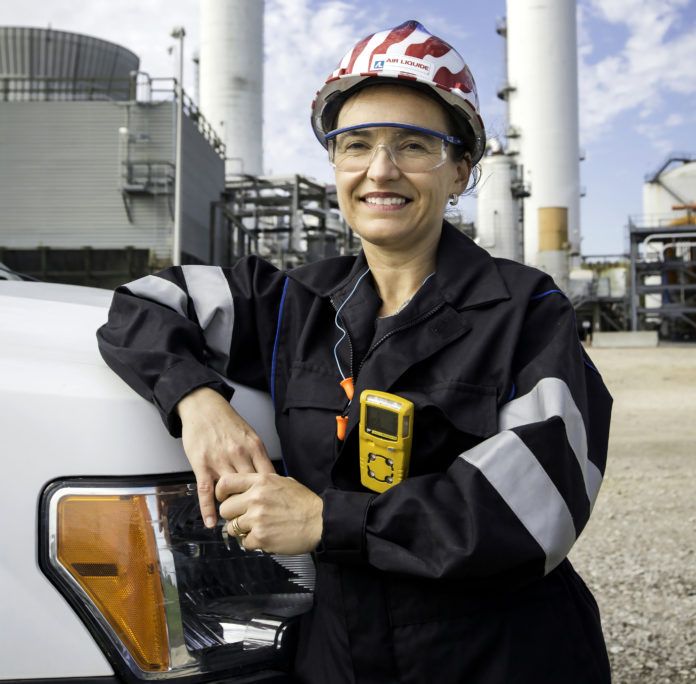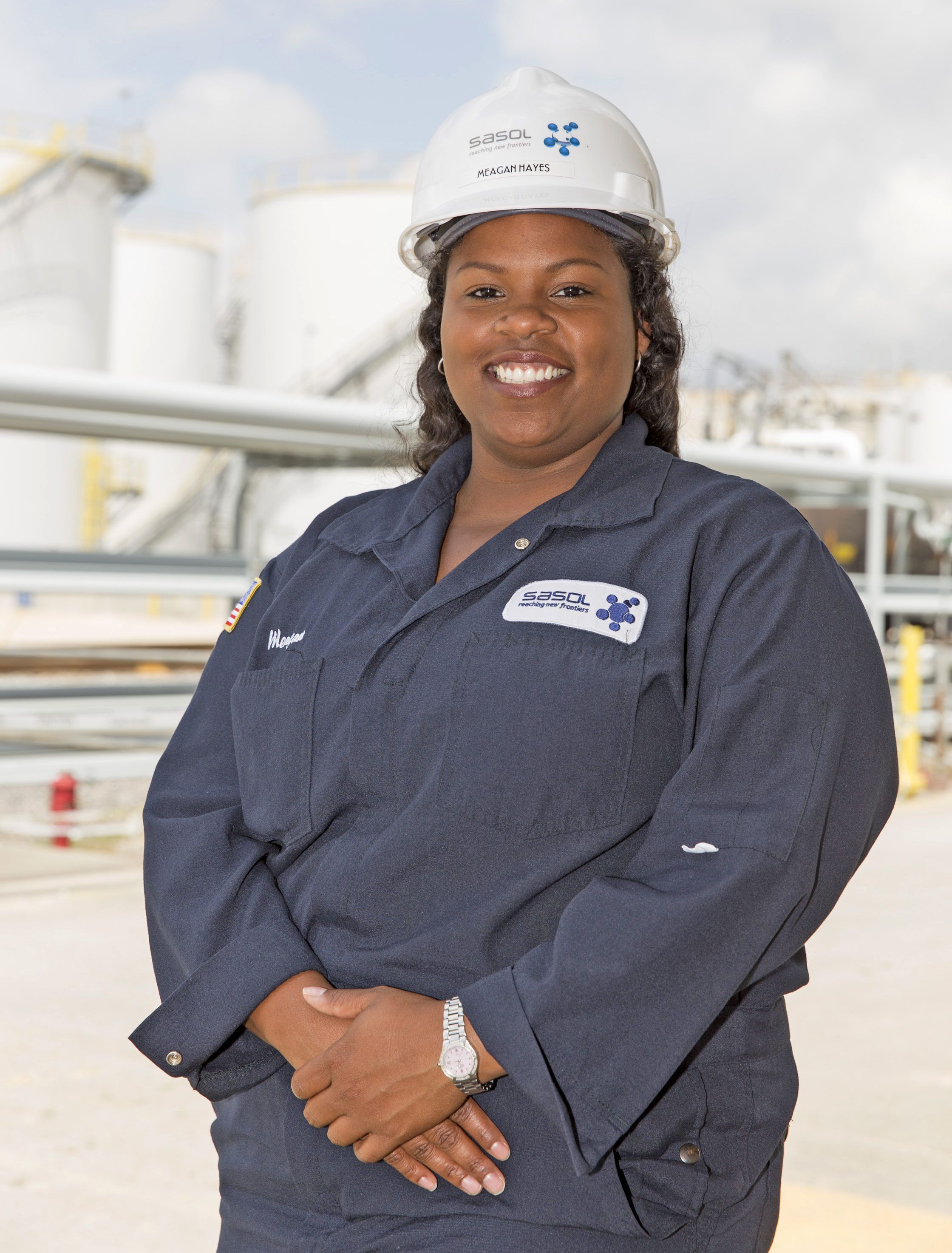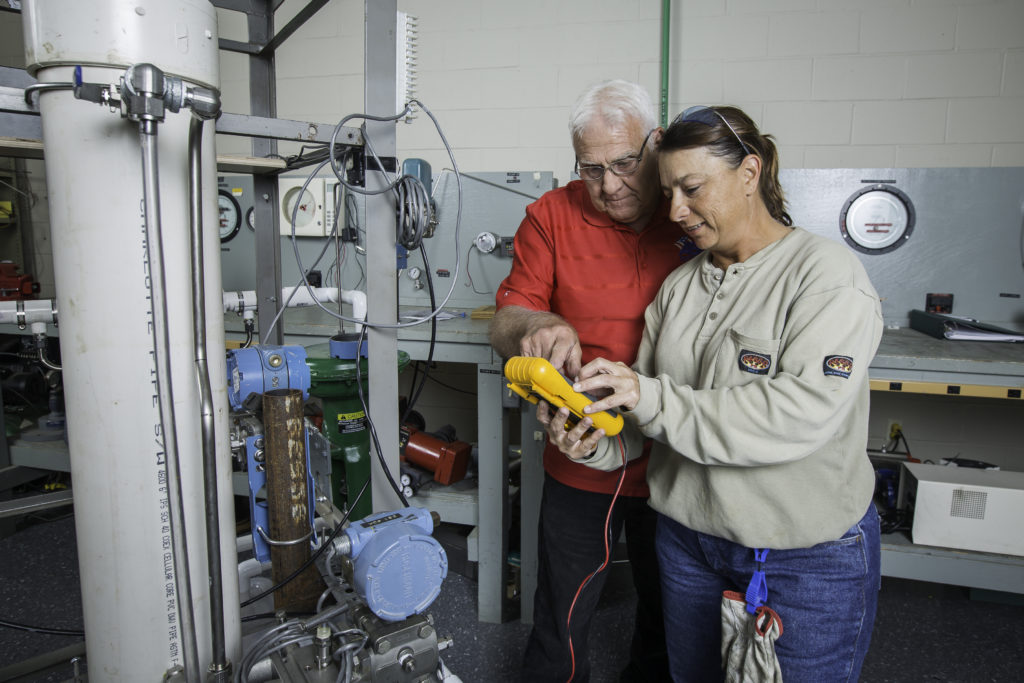
Everything seemed to be going according to plan for Lauren Cordell, a Sulphur High School valedictorian and Louisiana Tech University graduate. She had met many of her academic objectives, and she would soon begin earning her graduate degree in applied behavior analysis at McNeese State University.
But for Cordell, something wasn’t quite right. She was beginning to have doubts about her chosen career path, so she took a break from her studies to earn money by working a shutdown at a local process plant. After all, she had some knowledge of the plant environment, as her father had worked at a refinery for years.
She was blown away by the experience. “I just really liked being out there,” Cordell says. “I liked it so much I considered switching to engineering, because that was originally what I thought I wanted to do, but I was getting to the point in my life where I really needed to settle down into a career and that would mean a lot more school.” Instead, Cordell chose to begin process technology training at SOWELA Technical Community College in Lake Charles, and after graduation last year was snatched up by Grace’s refining catalyst plant in Sulphur as a first-year operator.
Cordell says she’s having the time of her life. “I have always liked working outside, working with my hands,” she says. “I like the troubleshooting and the problem solving aspects of it. I like being able to move around and be outside and enjoy the day.” As an entry level operator, Cordell is a loader/unloader, assisting with trucks and railcars bringing in raw materials and hauling shipments of catalyst.

OVERCOMING THE PERCENTAGES
Of the growing number of women in Louisiana industry like Cordell—from first-year operators to engineers to plant managers—most don’t feel like they’re breaking down any barriers. Instead, they attribute the challenges they face in these traditionally male-dominated jobs to personality differences, or a lack of experience, rather than gender bias.
That mindset is likely the reason they’ve excelled in their respective positions—by simply refusing to believe that they are at a disadvantage.
While it might be true that most women are not consciously discriminated against at plant sites, findings by the American Association of University Women assert that unconscious bias exists, and it severely limits women’s progress in engineering and scientific fields (“Breaking Through Barriers for Women and Girls,” 2009). Furthermore, women in nontraditional fields can find themselves in a “double bind”—viewed as less competent than their male peers and, when clearly competent, considered less likable.
These perceptions might subsequently create barriers to entry for women. According to the U.S. Bureau of Labor Statistics, while women accounted for more than half of the U.S. work force in several sectors in 2014, they continue to be substantially underrepresented in construction (9%) and manufacturing (29%), as well as other nontraditional jobs.
When broken down by specific industry, BLS statistics show that women comprised 21.6% of the labor force at refineries and 24.7% at chemical plants, nationwide, in 2014. On an encouraging note, the proportion of women across all markets with a college degree more than tripled from 1970 to 2014, increasing from 11.2% to 40%.

Whatever the causes, women who chose to enter nontraditional fields increasingly are rising to positions of leadership at Louisiana’s process plants. While the women we spoke to all possess a common affinity for STEM subjects (science, technology, engineering and math), none admit to having had any additional obstacles to overcome as women.
At ExxonMobil Plastics in Baton Rouge, Jennifer Dunphy took over as plant manager in March, and says her ascension to upper management was fueled by a strong skillset in math and science. “I am fortunate that I had a father who was a chemical engineer, as well as aunts and uncles in engineering, so I had a good perspective of what engineering was about,” Dunphy says.
Dunphy credits a strong female role model as being a significant influence in her early days. “In college, I was going to be a doctor because I thought I was going to save the world,” she says. “I realized that was not for me after my freshman year, and decided to pursue an internship in engineering because I already knew a lot about it. I spent one summer at a chemical company (Dow Chemical) working in operations, and I had a female supervisor who really influenced me to say, ‘OK. This is what I really want to do.’”
In her new role, Dunphy feels it’s now her turn to be an encourager to women entering the workforce. As such, she serves as a mentor through ExxonMobil’s Women’s Interest Network, a resource group that connects women within the company.
“I’ll put together a panel discussion or speaker to enable young women who are new to the industry to ask questions about my career, about work-life balance, as well as how we’ve managed to have a career and raise a family, and so forth.” Outreach is another part of the group’s efforts, including sponsoring events such as “Introduce a Girl to Engineering Day” and ExxonMobil site tours.
Thinking back on the struggles and challenges encountered throughout her career, Dunphy refuses to view her gender as a deterrent or limitation.
“I’ll be honest—I don’t focus on gender,” she adds. “I’ve been fortunate at ExxonMobil. I’ve worked on teams where I was the only female, but I’ve also worked on teams that were completely run by women. I really think a diverse workforce, whether that diversity is gender, personality style or whatever, can bring more productivity to a team. That’s where I try to focus; not so much on the gender.”
In her early years, the biggest hurdle for Hyun Brossett, current assistant plant manager and soon-to-be plant manager at Grace in Sulphur, was having to learn a second language and new way of life—not her gender. Along with her sister, Brossett moved to the U.S. from South Korea as a teenager in the 1980s to live with her aunt and uncle.
“The language barrier was the bigger challenge—I’m not going to sugarcoat it,” Brossett says. “You go to a different country and start school and everything is different. The culture is different, the language is different, everything. You have no friends and you don’t know how to make friends because you can’t talk to them. Yes, absolutely that was a huge challenge.”
Still, she overcame those obstacles—and the many more to follow—with her unwavering philosophy about life. “When you have to try something new, just jump in and do it,” she says. “Don’t think about it too much; just jump in and do it. Sink or swim. How well you apply that principle depends on what situation you are in. When your job changes, or you go from one position to another, they don’t give you three months to learn the job. It’s up to you to learn as fast as you can and try to do the very best job you can. That’s how things have been for me.”
Brossett says she’s always had an intense love for math. “I always wanted to know how things worked,” she adds. “It was such a good feeling when I understood. Once, my older sister and I spent time taking apart our TV just to see what was inside.”
Unfortunately, the TV didn’t work after re-assembly. “At the time, I didn’t really think much of it, but now that I’m older and look back, I’m thinking my parents could have been really mad.”

SEIZING OPPORTUNITY
Christine George, a vice president with Air Liquide whose oversight includes the Geismar plant, attributes her progress to an ability to take advantage of opportunities, rather than a well-thought-out plan.
“In my career, there were times when opportunities just came,” George says. “At other times, though, I really knew what I wanted to do—an example of that was moving to Air Liquide. It was something I wanted to do, and it took a little bit of effort, but in the end I persevered.”
George earned her chemical engineering degree in her native France, selecting a school that had an exchange program with the U.S. This enabled her to complete her master’s degree in engineering at the University of Houston. “Working in Houston and being exposed to the large petrochemical basin influenced me to pursue a career in that field,” she adds. “It would just fascinate me when I would go to those sites and tour them, and I guess that’s probably when my interest grew.”
Early in her education, George didn’t feel intimidated as a woman in a male-dominated world, since her school in France had “a reasonable ratio of women to men.” This changed when she began her practical training at a French steel mill her second year.
“That’s the first time I really felt like the only girl in town,” she says. “It was really interesting. People would say, ‘Are you lost?’ or ‘What are you doing here?’”
George stops short of saying her gender presented her with any undue obstacles or burdens, even as she rose through the ranks at Air Liquide and became plant manager. “I don’t know that I can say that my challenges were because I am a woman,” she adds. “Instead, taking on a new role was challenging because it was a significant stretch for me, professionally.”
George credits Air Liquide for pursuing a diversified workforce, “and obviously one of the dimensions of diversity is women in the workplace.” In her years with the company, she has noticed an important shift in the female-male dynamics in the workplace, especially as women have begun to take more leadership roles.
“I think the opportunities are becoming more numerous [for women], and I think there’s a more conscious effort to do that,” she says.
CHANGING PERCEPTIONS
The AAUW study cited above found that negative stereotypes regarding women’s abilities—particularly in the areas of engineering, math and science—persist despite considerable gains.
In Louisiana, organizations such as the Louisiana STEM Initiative and the Louisiana STEM Girls Collaborative seek to eliminate unconscious bias by raising awareness among middle school and high school students. By doing so, they hope to increase the numbers of females entering these fields.
Lou Papai, director of the Louisiana STEM Girls Collaborative and senior director of education at Sci-Port Discovery Center in Shreveport, says his group has made significant strides toward that objective. “One of the main purposes of the collaborative is to find ways to connect people across the state and leverage resources,” Papai says. “We know that there are numerous entities all over the state that do phenomenal things to help girls get into STEM disciplines—libraries, schools, universities. But the problem has been that we don’t know each other. Our purpose is to connect resources across Louisiana.”

As such, the collaborative fosters networking and the sharing of information and resources by awarding mini-grants to girl-serving programs and providing an online, searchable database.
“We also provide current, relevant research statistics and information for anyone wanting to reach girls in different populations and in different areas,” Papai adds. The collaborative maintains a leadership team comprised of industry, professional societies, K-12 and universities, for the purpose of taking a statewide approach to boosting gender equity.
The ultimate goal is to increase the numbers of students, overall, going into STEM fields. “We’re hurting for a STEM-educated workforce,” Papai says.
THE ECONOMIC DRAW
Growth in the numbers of females at Louisiana process plants is not limited to engineering or management. The allure of high wages and readily available training have recently begun to attract more females into entry-level positions.
For Meagan Hayes, first-year processor at Sasol in Lake Charles, the choice to apply for a job there was simple. The single mother saw it as an opportunity to provide a better standard of living for her 11-year-old daughter. Hayes is currently part of a 200-person team writing operating procedures in preparation for the plant’s startup.
The Lake Charles native graduated from Washington-Marion Magnet High School in 2004, then from McNeese State University in 2010 with a bachelor’s degree in applied and natural sciences. “After graduation, I worked full time at a local bank for a few years and had reached a point where I couldn’t advance any further,” Hayes says. “I learned about the Sasol expansion in the news, and decided to go back to school.”
Hayes pursued training in process technology at SOWELA Technical Community College, graduating in 2012 with a 3.6 GPA. “I finished in just two semesters because several of my credits transferred from McNeese.”
“I attribute my success to my daughter,” Hayes adds. “She is involved in a lot of clubs, and she’s pretty good at softball. I need to be able to afford those things comfortably, so I knew I needed to do better for both myself and her.”
Grace’s Cordell also says that money was a big motivation for her career change. “I knew that I wanted something where I would make good money and be able to support myself,” she adds. Despite friends and family warning her that she might be treated differently as a woman in her new job, Cordell hasn’t noticed any of that.
“I was expecting that kind of an attitude, and when I got here it really hasn’t been that way,” she says. “You kind of go in with that mindset and then you see that it’s not true.”
“I think it’s all just normal stuff,” she adds. “You have to learn the position, and you have to prove that you can do the job. With the men it’s kind of understood that they can do the job, and that they can handle the labor and the physical aspects. So, as a woman you have to show them you can do it.”

FEMALE ENROLLMENT UP
Demand for skilled labor training is also growing among women. At Associated Builders and Contractors – Bayou Chapter’s worker training program in New Orleans, female enrollment unexpectedly shot up to 21 students this spring, after hovering around an unimpressive two or three per semester for years. While that still comprises a small percentage of those to graduate this May, Claire Obgartel, ABC’s vice president of workforce development, says it represents the highest number of females to ever enroll in the program.
“I’m not really sure what the driving force is behind it,” Obgartel says. “It just kind of happened, and it’s crossing over multiple crafts. We have students being trained in electrical, pipefitting, welding and scaffolding.” Most of the students are sponsored by industrial contractors such as Brock Services, Turner Industries and Pala Group.
“These students see people doing other things and they want to make a change,” Obgartel adds. “One of our female electrical students does electrical drawings for Dow, and she wanted to learn more about the electrical trade to improve her skillset.”
David Alexander, director of training at ABC – Pelican Chapter in Baton Rouge, says women comprise a small percentage of the approximately 3,400 students who enter training at facilities in Baton Rouge and Lake Charles. Still, the high-wage environment has attracted some females to pursue craft training. “We do have females in our evening programs,” Alexander says.

Encouraging statistics can also be found at LSU, where there has been a perceptible surge in female enrollment in nontraditional curricula, particularly construction management.
Charles Berryman, chairman of LSU’s Construction Management Department, has noticed a sizeable increase in the number of females entering the construction management curriculum just this year. “About 7.5% of last year’s enrollment were females, the highest percentage since we began keeping track in 2008,” Berryman says. In fact, the current president of LSU’s Construction Student Association, Ameenah Henderson, is a woman.

Berryman says there is an undeniable trend toward more females in the program. “Something else we’ve noticed … the girls get hired faster than the boys,” he adds. “They’re just better at multitasking. They get into scheduling, estimating, contracts, accounting, and so on.”
He feels the increasing numbers can be attributed to changing perceptions, fueled by outreach efforts and career fairs.
For what gender boundaries there are, whether conscious or unconscious, they’re best addressed at a young age, says Papai of the Louisiana STEM Girls Collaborative. His group has made breaking down barriers at the middle school and high school levels its primary goal.
“You’re seeing more young women in middle school and high school showing an interest in STEM careers, and they test better in science and math than the boys,” Papai says. “But, in the past, when they went to college they didn’t go into those fields. We’re beginning to see that slowly change.”
Originally published in the second quarter 2016 edition of 10/12 Industry Report.






